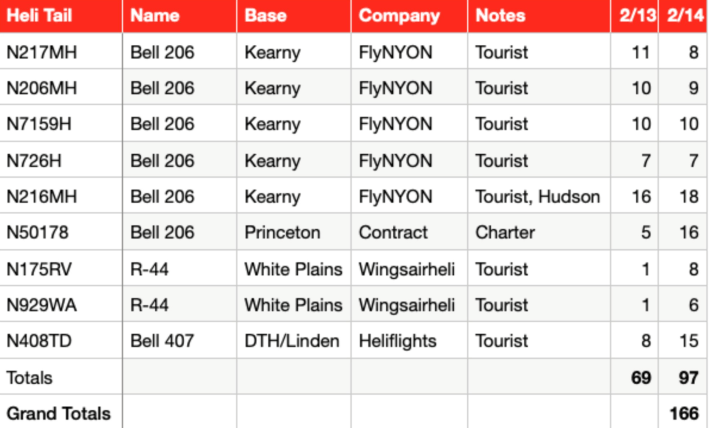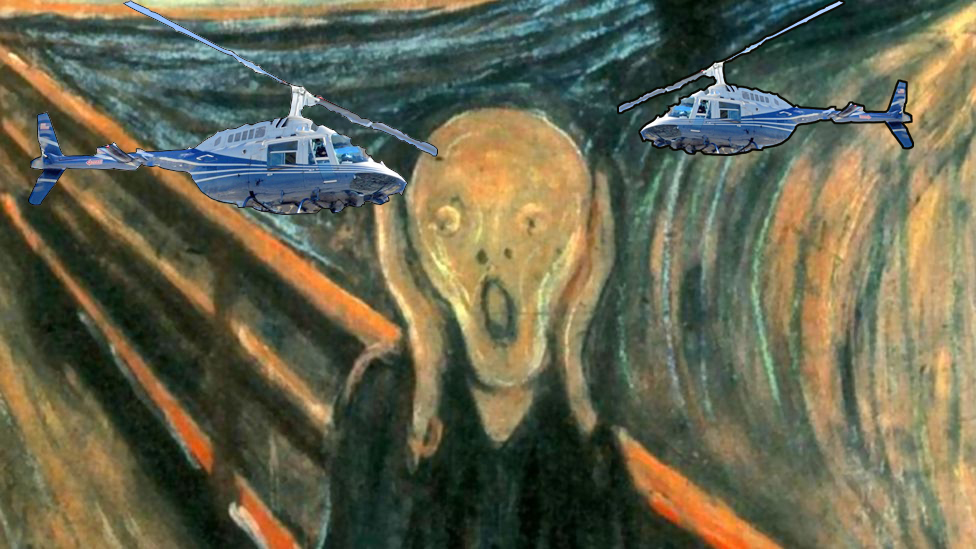What's the cost of losing one's mind?
A Brooklyn council member is demanding that the city investigate whether the economic benefit of helicopter travel to, from and simply around the city outweigh the horrendous, but harder-to-calculate, deleterious affect of the noise and pollution created by the wheezing whirlybirds.
Council Member Brad Lander put in a preliminary legislative request for such a "cost-benefit" study after the legislature's Economic Development Committee took up a bill this week to consider limiting helicopter companies' use of city-owned heliports to slightly lower-noise vehicles. Lander said he was motivated to demand more information because the Council simply does not know if the city has made the right economic calculation by putting the desires of tourists and well-heeled travelers ahead of every day New Yorkers who are suffering on the ground.
"At the hearing on Wednesday, the Economic Development Corporation said that the entire helicopter industry in New York City offers a few dozen jobs and $2- to $3 million per year in revenue," Lander said, citing the EDC's own statistics about rent that it charges at the city-run heliports on the East River in Lower Manhattan and at E. 34th Street (a third helipad is operated by the Hudson River Part Trust and would not be affected by the council bill).
"Those benefits are clearly quite modest, but they have at least been calculated," Lander added. "But the quite significant human harm of helicopter noise and pollution has not been calculated."
Is this the most obnoxious tour helicopter route ever?@wingsair from White Plains--slicing thru @CentralParkNYC at 1300 ft, circling Midtown repeatedly, then circling Lower Manhattan, before heading out on a 15-minute joyride at 150-175 ft through the harbor & BK waterfront. pic.twitter.com/Y6nwKvgeuc
— Julia Vitullo-Martin (@JuliaManhattan) February 21, 2021
Indeed, the Department of Health and Mental Hygiene did not testify at the hearing or provide information to the council about the affect of noise on people who find themselves under the scores of helicopters that circle or cross New York City every weekend.
"The bills in question were not related to the Health Department," said agency spokesman Michael Lanza. "However, should there be information that we can offer, we are always standing by to help."
If Lander's legislative request (it is not yet a formal bill) becomes law, the Department of Health will have to step up its game. When Streetsblog asked for the "information" to which Lanza referred, another agency official sent over three documents:
- A dataset from 2009 which said that 1,181,000 adult New Yorkers — or roughly one-fifth of the total non-kid population — had reported "experiencing noise disruption three or more times per week," though that extremely high number is not broken down by source of the noise.
- A short 2014 department briefing paper that said outright that New York City does not "systematically monitor ambient noise or the prevalence of noise disturbance." Nonetheless, the number of New Yorkers affected by noise — at least based on 311 calls — had risen to 39 percent, with half of those saying that the disruptions were three or more times weekly. (It's important to note that 56 percent of noise complaints stemmed from "vehicles," which could be used as evidence that the Department of Health could do more to limit vehicle access to residential neighborhoods, though the agency has consistently refused to play a role in that debate, as Streetsblog has reported.)
- A 2018 briefing paper that reported that "82 percent of New Yorkers have their sleep disturbed at least once per week — and 64 percent of those people, roughly 3,189,000 adults, said noise was the culprit. Again, the paper did not distinguish what kind of noise, but did report that "traffic" was a leading cause of human misery.
"Noise can cause stress and other psychological problems," the 2014 briefing paper admitted, yet offered no prescription for the illness.
And that's where Lander hopes to fill the gap, describing the need for a "misery index" of noise and pollution that can be compared to the EDC rent figure to determine if New Yorkers' misery is worth the revenue that the misery-causing machines bring in. (Some helicopters still run on dangerous leaded fuel, for example.)
"You can measure the decibels that a helicopter produces, but that is not a measure of how miserable they make some people feel," said Lander, who is running for Comptroller. "Not everyone feels noise the same way. There are some people who cannot block it out. Those are our neighbors and they are miserable as a result of these helicopter flights. We should look to public health experts to develop a misery index to figure out how many people are affected and what kind of impacts it has on their daily lives.
"My hunch is the number of people who are affected outweighs the modest economic benefit, but we don't have the data," Lander added. "Taking tourists over the Statue of Liberty or to the Hamptons is one thing, but human misery is another."
The Economic Development Corporation said pollution from helicopters is not a problem, even though many helicopters still use leaded fuel.
"Air quality that has been monitored at both [city-owned] heliports have been found to be within air quality limits for the NYC area," an agency spokesman said. (When Streetsblog asked the agency to provide the pollution readings so we could independently assess them, the agency said it would get back to us, but did not immediately do so. UPDATE: The agency has provided the information, which we are including at the bottom.)

The misery from helicopters is rising — and likely undercounted. It is not possible to report helicopter noise directly from the 311 mobile app — which most people would be using outdoors, whether they are likeliest to encounter helicopter noise — but the app does link would-be complainants to a website where the complaint can be taken. (New Yorkers can report noise from news, police, tourist or commuter helicopters, but the Economic Development Corporation does not have jurisdiction over news or NYPD helicopters, so those complaints are merely logged.)
The number of complaints about tourist and commuter helicopters rose nearly 270 percent, from 840 complaints in 2017 to 3,094 complaints in 2019, according to the city's 311 logs. (The City published higher numbers late last year because 311 data can be parsed different ways.) The majority of those 311 cases result in no city action because the majority of non-police flights originate outside of the two city-operated heliports, which Julia Vitullo-Martin has painstakingly documented. (The Council bill that was discussed last week is considered toothless, given that it does not seek to rein in out-of-town helicopter operators or NYPD choppers, which had the most complaints against them last year, given the death of tourist flights during the pandemic, as Streetsblog reported.)
Anyone wanting to assess the "misery" of helicopters need only talk to Melodie Bryant, a Manhattan resident who testified at the Wednesday hearing. Bryant had counted more than 166 helicopters that passed over her Chelsea neighborhood during the weekend before the hearing (many passing over twice — on their way to and from a helipad in New Jersey).
How bad is it? We asked Bryant to describe what helicopter noise does to her. Here is what she said:
I'm sitting in my office trying to get work done. I hear faint rumbling and have a sinking feeling because I know what it is: a tourist helicopter headed towards us from New Jersey. From the moment that rumble is audible, I know I won't be able to concentrate because this is just a warning. There will be two assaults, one after another: the first turning over Chelsea, then back over us again on fly back to Jersey. The flight path is familiar: up to Central Park, circling the Reservoir, back down the East Side and over us one more time. But those are just the typical ones. Sometimes the looping goes on over Chelsea for a half hour or more. I won't have my brains back until the final assault is over.
The sorties themselves are like waves of nausea that rumble in my lungs and my brain, a pressure from above. There is a familiar, growing sense of dread, a sensory bracing for it, when the noise and pressure peak; then gradual relief when the fly-over fades, and the senses start to heal. But there are only a couple of minutes before the process starts all over again because these flights are relentless and last till midnight. There are times I want to run out of the house to escape, but there is no escape - the street is even worse. It's totally distracting. The only pressure valve I have is to report these helicopters for the record, but this takes time. There are days when it seems all I do is report helicopters, and never get my thread of concentration back. I have lost countless hours of productivity I will never get back, to these helicopter assaults.
The Department of Health declined to comment on Lander's proposal. Streetsblog also asked the agency if it could provide "evidence that [the agency] is aggressively, proactively working to reduce noise in NYC?" The agency said that Streetsblog should contact the city Department of Environmental Protection, which we did. The DEP sent over this response:
"DEP, along with other agencies, enforces the city’s Noise Code. The Code, however, does not cover helicopters as a source of noise. DEP therefore lacks jurisdiction in this area."
Update: Regarding the air quality readings provided by the Economic Development Corporation, they show that levels of Acetaldehyde, 1,3-Butadiene and Benzene are below "permitted exposure level" as defined by Occupational Safety and Health Organization. The actual amount of the pollutants was said to be "not detected" at the heliports for most months for Acetaldehyde, which has an exposure level of 200,000 parts per billion, and Benzene, which has an exposure level of 1,000 ppb. In March, 2020, the level of Butadiene, however, rose from "not detectable" to .76 ppb. In July, 2020, it rose again to 2.6 ppb. It is unclear why.






